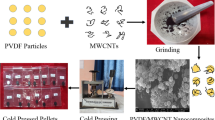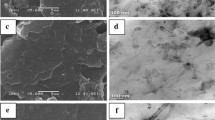Abstract
Ternary-nanocomposites of polyamide 12 (PA-12) and multi-walled carbon nanotubes-embedded-polypropylene (MWCNT-embedded-PP) were fabricated by direct-melt-mixing-route and characterized for their dispersion-nanomorphology and phase-selective micromorphology. The crystallite sizes remained in the range of 8–9 nm and a broadening in loss-tangent peaks shifting towards higher temperatures with MWCNT was observed. The DC electrical conductivity remained dependent on the change in morphology from domain-dispersed (MWCNT-embedded-PP dispersed in PA-12 matrix) in PA-12/PP-MWCNT (70:30) to quasi-co-continuous (MWCNT-embedded-PP forming elongated domains of PP-MWCNT dispersed in PA-12 matrix tending to be near-continuous) in PA-12/PP-MWCNT (60:40). The conceptual feasibility of designing nanocomposites wherein the switch-over in solid-state relaxation behaviour vis-a-vis electrical conductivity is thus found to be controlled by morphology that ensures phase-selective conductive response for functional applications, as in flexible electronics, unlike the ones with rigid and high melting (thermally stiff) polyamides such as polyamide 6 or polyamide 66.






Similar content being viewed by others
References
Hu G, Zhao C, Zhang S, Yang M, Wang Z (2006) Low percolation thresholds of electrical conductivity and rheology in poly (ethylene terephthalate) through the networks of multi-walled carbon nanotubes. Polymer. 47:480–488
Ding X, Wang J, Zhang S, Wang J, Li S (2016) Carbon black-filled polypropylene as a positive temperature coefficient material : effect of filler treatment and heat treatment. Polym Bull 73:369–383
Zhao S, Lou D, Zhan P, Li G, Dai K, Guo J, Zheng G, Liu C, Shen C, Guo Z (2017) Heating-induced negative temperature coefficient effect in conductive graphene/polymer ternary nanocomposites with a segregated and double-percolated structure. J Mater Chem C 5:8233–8242
Mamunya YP, Muzychenko YV, Lebedev EV, Boiteux G, Seytre G, Boullanger C, Pissis P (2007) PTC effect and structure of polymer composites based on polyethylene / Polyoxymethylene blend filled with dispersed iron. Polym Eng Sci 47:34–42
Rybak A, Boiteux G, Melis F, Seytre G (2010) Conductive polymer composites based on metallic nanofiller as smart materials for current limiting devices. Compos Sci Technol 70:410–416
Zeng Y, Lu G, Wang H, Du J, Ying Z, Liu C (2014) Positive temperature coefficient thermistors based on carbon nanotube/polymer composites. Sci Rep 4:1–7
Lee J, Kwan S, Hoon N (2006) Effects of the addition of multi-walled carbon nanotubes on the positive temperature coefficient characteristics of carbon-black-filled high-density polyethylene nanocomposites. Scripta Mater 55:1119–1122
Xiang Z, Chen T, Li Z, Bian X (2009) Negative temperature coefficient of resistivity in lightweight conductive carbon nanotube/polymer composites. Macromol Mater Eng 294:91–95
Cui X, Zhu Y, Jiang W (2018) Lightweight and conductive carbon black/chlorinated poly(propylene carbonate) foams with a remarkable negative temperature coefficient effect of resistance for temperature sensor applications. J Mater Chem C 6:9354–9362
Qu Y, Zhang W, Dai K, Zheng G, Liu C, Chen J, Shen C (2014) Tuning of the PTC and NTC effects of conductive CB / PA6 / HDPE composite utilizing an electrically superfine electrospun network. Mater Lett 132:48–51
Arboleda L, Ares A, Abad MJ, Ferreira A, Costa P, Lanceros-Mendez S (2013) Piezoresistive response of carbon nanotubes-polyamides composites processed by extrusion. J Polym Res 20:326
Wu CM, Cheong SS, Chang TH (2016) Rheological properties of graphene/nylon 6 nanocomposites prepared by masterbatch melt mixing. J Polym Res 23:242
Chen J, Hou Y, Zhang M, Liu D, Yang JH, Wang Y, Zhou ZW, Yuan GP (2014) Combined effect of compatibilizer and carbon nanotubes on the morphology and electrical conductivity of PP / PS blend. Polym Adv Technol 25:624–630
Fenouillot F, Cassagnau P, Majesté JC (2009) Uneven distribution of nanoparticles in immiscible fluids : morphology development in polymer blends. Polymer 50:1333–1350
Zonder L, Ophir A, Kenig S, McCarthy S (2011) The effect of carbon nanotubes on the rheology and electrical resistivity of polyamide 12/high density polyethylene blends. Polymer 52:5085–5091
Baudouin AC, Bailly C, Devaux J (2010) Interface localization of carbon nanotubes in blends of two copolymers. Polym Degrad Stab 95:389–398
Li Y, Shimizu H (2008) Conductive PVDF/PA6/CNTs nanocomposites fabricated by dual formation of cocontinuous and nanodispersion structures. Macromol 41:5339–5344
Baudouin AC, Devaux J, Bailly C (2010) Localization of carbon nanotubes at the interface in blends of polyamide and ethylene-acrylate copolymer. Polymer 51:1341–1354
Xiang F, Shi Y, Li X, Huang T, Chen C, Peng Y, Wang Y (2012) Cocontinuous morphology of immiscible high density polyethylene/polyamide 6 blend induced by multiwalled carbon nanotubes network. Eur Polym J 48:350–361
Otero-Navas I, Arjmand M, Sundararaj U (2017) Carbon nanotube induced double percolation in polymer blends: morphology, rheology and broadband dielectric properties. Polymer 114:122–134
Liu XQ, Yang W, Xie BH, Yang MB (2012) Influence of multiwall carbon nanotubes on the morphology, melting, crystallization and mechanical properties of polyamide 6/acrylonitrile-butadiene-styrene blends. Mater Des 34:355–362
Mcnally T, Murphy WR, Lew CY, Turner RJ, Brennan GP (2003) Polyamide-12 layered silicate nanocomposites by melt blending. Polymer 44:2761–2772
Das D, Satapathy BK (2014) Designing tough and fracture resistant polypropylene/multi wall carbon nanotubes nanocomposites by controlling stereo-complexity and dispersion morphology. Mater Des 54:712–777
Phang IY, Liu T, Mohamed A, Pramoda KP, Chen L, Shen L, Chow SY, He C, Lu X, Hu X (2005) Morphology, thermal and mechanical properties of nylon 12/organoclay nanocomposites prepared by melt compounding. Polym Int 54:456–464
Bindumadhavan K, Srivastava SK, Mahanty S (2013) MoS2–MWCNT hybrids as a superior anode in lithium-ion batteries. Chem Comm 49:1823–1825
Kim UJ, Eom SH, Wada M (2010) Thermal decomposition of native cellulose: influence on crystallite size. Polym Degrad Stabil 95:778–781
Gao X, Zhang S, Mai F, Lin L, Deng Y, Deng H, Fu Q (2011) Preparation of high performance conductive polymer fibres from double percolated structure. J Mater Chem 21:6401–6408
Yan D, Li X, Ma HL, Tang XZ, Zhang Z, Yu ZZ (2013) Effect of compounding sequence on localization of carbon nanotubes and electrical properties of ternary nanocomposites. Compos Part A Appl Sci Manuf 49:35–41
Cohen E, Zonder L, Ophir A, Kenig S, McCarthy S, Barry C, Mead J (2013) Hierarchical structures composed of confined carbon nanotubes in cocontinuous ternary polymer blends. Macromol 46:1851–1859
Salehiyan R, Ray SS (2018) Tuning the conductivity of Nanocomposites through nanoparticle migration and Interface crossing in immiscible polymer blends : a review on fundamental understanding. Macromol Mater Eng 1800431:1–33
Mamunya Y, Levchenko V, Boiteux G, Seytre G, Zanoaga M, Tanasa F, Lebedev E (2016) Controlling Morphology , Electrical , and Mechanical Properties of Polymer Blends by Heterogeneous Distribution of Carbon Nanotubes. Polym Compos 37:2467–2477
Zonder L, McCarthy S, Rios F et al (2014) Viscosity ratio and interfacial tension as carbon nanotubes distributing factors in melt-mixed blends of polyamide 12 and high-density polyethylene. Adv Polym Technol 33:1–7
González I, Eguiazábal JI, Nazabal J (2012) Attaining high electrical conductivity and toughness in PA6 by combined addition of MWCNT and rubber. Compos Part A Appl Sci Manuf 43:1482–1489
Tao F, Nysten B, Baudouin AC, Thomassin JM, Vuluga D, Detrembleur C, Bailly C (2011) Influence of nanoparticle-polymer interactions on the apparent migration behaviour of carbon nanotubes in an immiscible polymer blend. Polymer 52:4798–4805
Hoepfner JC, Loos MR, Pezzin SH (2019) Role of the degree of acetalization on dynamic mechanical properties of polyvinyl butyral/carbon nanotube composites. J Appl Polym Sci 43:48146
Abdullah SA, Iqbal A, Frormann L (2008) Melt mixing of carbon fibers and carbon nanotubes incorporated polyurethanes. J Appl Polym Sci 110:196–202
Li RKY, Liang JZ, Tjong SC (1998) Morphology and dynamic mechanical properties of glass beads filled low density polyethylene composites. J Mater Process Technol 79:59–65
Jogi BF, Sawant M, Brahmankar PK, Ratna D, Tarhekar MC (2014) Study of mechanical and crystalline behavior of polyamide 6/Hytrel/carbon nanotubes (CNT) based polymer composites. Procedia Mater Sci 6:805–811
Bindu MG, Satapathy BK, Jaggi HS, Ray AR (2013) Size-scale effects of silica on bis-GMA / TEGDMA based nanohybrid dental restorative composites. Compos Part B Eng 53:92–102
Chen J, Du XC, Zhang WB, Yang JH, Zhang N, Huang T, Wang Y (2013) Synergistic effect of carbon nanotubes and carbon black on electrical conductivity of PA6/ABS blend. Compos Sci Technol 81:1–8
Hoseini AHA, Arjmand M, Sundararaj U, Trifkovic M (2017) Significance of interfacial interaction and agglomerates on electrical properties of polymer-carbon nanotube nanocomposites. Mater Des 125:126–134
Hoseini AHA, Arjmand M, Sundararaj U, Trifkovic M (2017) Tunable electrical conductivity of polystyrene/polyamide-6/carbon nanotube blend nanocomposites via control of morphology and nanofiller localization. Eur Polym J 95:418–429
Author information
Authors and Affiliations
Corresponding author
Additional information
Publisher’s note
Springer Nature remains neutral with regard to jurisdictional claims in published maps and institutional affiliations.
Rights and permissions
About this article
Cite this article
Sethy, S., Satapathy, B.K. Microstructural interpretations on thermo-mechanical relaxation and electrical conductivity of polyamide-12/polypropylene-MWCNT nanocomposites. J Polym Res 27, 84 (2020). https://doi.org/10.1007/s10965-020-02045-0
Received:
Accepted:
Published:
DOI: https://doi.org/10.1007/s10965-020-02045-0




